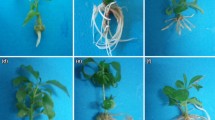Abstract
Exeised roots ofSolanum laciniatum Ait. grown in vitro in a liquid medium will form the typical rich white callus with a high water content. Its formation is made possible by the presence of 2,4-dichlorophenoxyacetic acid and niyo-inositol in the nutrient medium. Choline, ascorbic acid, riboflavin, calcium pantothenate and biotin are inactive. A mixture of thiamine, pyridoxine and nicotinic acid will induce only slight proliferation.
Abstract
Izolované koíeny druhuSolanum laciniatum AIT., pěstované in vitro, vytváfejí v tekutém médiu bohaty typicky bílý kalus s vysokým obsahem vody. Jeho vznik je podminěn píítomností kyseliny 2,4-dichlorfenoxyoctové a myo-inositolu v živné pdě. Cholin, kyselina askorbová, riboflavin, Ca-pantotenát a biotin jsou inaktivní; směs thiaminu, pyridoxinu a kyseliny nikotinové indukuje jen velmi slabou proliferaci.
Abstract
Корни растений вида Solanum laciniatum AIT. выращиваемые in vitro, образуют в жидкой среде большой водянистый каллус белого цвета характерной формы. Его образование обусловлено добавлением 2, 4-дихлорфеноксиуксус ной кислоты и миоинозита.
Similar content being viewed by others
References
Anderson, L., Wolter, K. E.: Cyclitols in plants: biochemistry and physiology. - Ann. Rev. Plant Physiol.17: 209–222, 1966.
Barnes, R. L., Nayloe, A. W.: Cultures of pine root callus and the use ofPinus clausa callus in preliminary metabolic studies. - Bot. Gaz.120: 63–66, 1958.
Barnes, R. L., Naylor, A. W.: In vitro culture of pine roots and the use ofPinus serotina roots in metabolic studies. - Forest Sci.5: 158–163, 1959.
Braun, A. C.: A physiological basis for autonomous growth of the crown gall tumor cell. - Proc. Nat. Acad. Sci. U.S.44: 344–349, 1958.
Dangsohat, G.: Inosite und verwandte Naturstoffe (Cyclite). - Encyclopedia of Plant Physiol. In: W. Ruhland (ed.): Handbuch der PfanzenphysiologieVI : 363–389, Berlin, Göttingen, Heidelberg 1958.
Fox, J. E.: Growth factor requirements and chromosome number in tobacco tissue cultures. - Physiol. Plant.16: 793–803, 1963.
Gautheret, R. J.: La Culture des Tissus Végétaux. - Masson et Cie, Paris 1959.
Jagendorf, A. T.: An atypical growth of cabbage seedling roots. II. The nitrogen co-factor and relationship to auxin activity.- Am. J. Bot.39: 546–552, 1952.
Jagendorf, A. T., Bonner, D. M.: An atypical growth of cabbage seedling roots. III. Tissue culture and physiological comparisons of typical and atypical roots. - Plant Physiol.28: 415–427, 1953.
Jagendorf, A. T., Bonner, D. M., Naylor, A. W.: An atypical growth of cabbage seedling roots. I. Morphology, histology, and induction conditions. - Bot. Gaz.113: 334–347, 1952.
Levine, M.: The effect of growth substances and chemical carcinogens on fibrous roots of carrot tissue grown in vitro. -Am. J. Bot.38: 132–138, 1951.
Linsmaier, E. M., Skoog, F.: Organic growth factor requirements of tobacco tissue cultures. - Physiol. Plant.18: 100–127, 1965.
Loewenberg, J. R., Skoog, F.: Pine tissue culture. - Physiol. Plant.5: 33–36, 1952.
Narayana, R.: Growth and differentiation ofPelargonium hortorum tissue cultures. - Ph.D. Thesis. University of Wisconsin 1963. Cit. Linsmaier, Skoog, 1965.
NobÉcoubt, P.: Sur les radicelles naissant des cultures de tissus du tubercule de Carotte. - CR. Soc. Biol.130: 1271–1272, 1939.
Norton, J. P., Boll, W. G.: Callus and shoot formation from tomato roots in vitro. - Science119: 220–221, 1954.
Pollard, J. K., Shaktz, E. M., Steward, F. C: Hexitols in coconut milk: their role in nurture of dividing cells. - Plant Physiol.36: 492–501, 1961.
Risser, P. G., White, P. R.: Nutritional requirements of spruce tumor cells in vitro. - Physiol. Plant.17: 620–635, 1964.
Robbins, W. J., White, V. B.: Limited growth and abnormalities in excised corn root tips. - Bot. Gaz.98: 209–242, 1937.
ŘeŘābek, J.: Atypisches Wachstum isolerter in vitro kultivierter Wurzeln vonSolanum laci-niatum Ait.- Naturwissenschaften51: 67–68, 1964.
Steinhart, C., Anderson, L., Skoog, F.: Growth promoting effect of cyclitols on spruce tissue cultures. - Plant Physiol.37: 60–66, 1962.
Torrey, J. G., Reinert, J.: Suspension cultures of higher plant cells in synthetic media. - Plant Physiol.36: 483–491, 1961.
Torkey, J. G., Shigemura, Y.: Growth and controlled morphogenesis in pea root callus tissue grown in liquid media. - Am. J. Bot.44: 334–344, 1957.
Tryon, K.: Root tumors onNicotiana affinis seedlings grown in vitro on a malt and yeast extract medium. - Am. J. Bot.42: 604–611, 1955.
West, F. R., jr., Mika, E. S.: Synthesis of atropine by isolated roots and root-callus cultures of belladonna.- Bot. Gaz.119: 50–54, 1957.
White, P. R.: A Handbook of Plant Tissue Culture. - Roland Press, New York 1943.
Wolter, K. E.: In vitro cultivation of ash, aspen and pin oak callus tissues. - Ph. D. Thesis. University of Wisconsin 1964. Cit. LinsmÁieb, SkooG, 1965.
Wolter E., Skoog F.: Nutritional requirements ofFraxinus callus cultures. - Am. J. Bot.53: 263–269, 1966.
Wood, H. N., Braun, A. C: Studies on the regulation of certain essential biosynthetic systems in normal and crown-gall tumor cells. - Proc. Nat. Acad. Sci. U.S.47: 1907–1913, 1961.
Author information
Authors and Affiliations
Rights and permissions
About this article
Cite this article
ŘeŘÁbek, J. Role of 2,4-dichlorophenoxyacetic acid and of myoinositol in the formation of the callus on excised roots ofSolanum laciniatum AIT. Biol Plant 9, 285–291 (1967). https://doi.org/10.1007/BF02929769
Received:
Issue Date:
DOI: https://doi.org/10.1007/BF02929769




